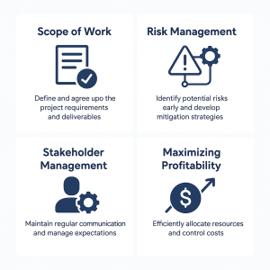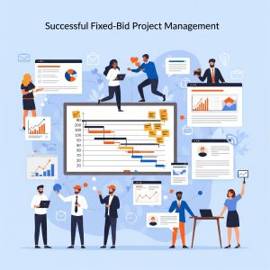Managing fixed cost projects: Insights from the field
Introduction
Managing fixed price projects isn’t rocket science—but it certainly requires vision, careful planning, and sharp execution to make it successful.
Recently, I had the opportunity to work on an end-to-end fixed price project, and it was a transformative experience. Not only did it offer deep insights into the nuances of managing fixed price engagements, but it also broadened my understanding of the various challenges, dependencies, and planning techniques that are critical to success.
Transitioning from a Time & Material model to Fixed Price is an entirely different ball game—it demands a shift in mindset, accountability, and a more disciplined approach to scope, timelines, and cost control.
In this blog, I’ll be sharing the best practices and key learnings I gathered through this journey—learnings that can hopefully help others navigate similar transitions or managing fixed price deliveries.

Components of Fixed Price project
1. Scope of work – This seems to be really a contradiction in the Agile world. On one side we say we should be Agile enough to accept changes but when it comes to fixed price projects, we need to be very clear on the scope of work on which the project was estimated and the timelines were committed.
Though at the same time, it is important to keep the client satisfaction and requirements changes in mind, we should be able to either push back the changes that could cause a lot of scope creep or suggest alternatives(CRs for next phase, de-prioritize any task) to make sure we do not run behind schedule when we accept any new changes post the initiation of the development work.A strict change control mechanism should be followed.
2. Risk management – For Fixed price projects, since the scope should remain the same, there could be a lot of issues that are identified at each phase of the project i.e. actual requirements grooming, technical dependencies, implementation phase, NFRs.
For this it is really critical to maintain a risk register and review it frequently (almost daily). This would help us mitigate the risks early, take action, discuss with the client on long pending risks, proactively highlight them with the client, analyse the delay caused due to these opens, categorise the risk types and owner of the risks.
This would help us be on top of our risks and pending work and would later help us if the timelines are getting deviated due to these.This would also help us with fallback plans in case of any critical items.
3. Stakeholder management – This is a key aspect of managing any fixed price project. It is often seen that once the timelines are set, project is kicked off there could be some resistance from the stakeholders to accept any sco[pe creeps, or major requirements issues that may be identified in due course of the project.
To avoid these situations, the above mentioned risk register would really come in handy while discussing such situations with the clients. Apart from this documentation of the work being done is also really important. maintaining MoMs, critical discussions over emails, having regular cadences, approvals are critical to make sure in case of any issues these are handy.
4. Maximising Profitability – A critical aspect of managing fixed price projects is generating revenue. Considering, the scope might change in between which has to be taken up by the development team even after negotiating with the client, that too within the same timelines. In sucha. scenario it becomes really difficult to gain profitability from the project leave out maximising it.
For this we can take up some action plans like:
-> Start with a lean team to close the design and discovery phase
-> Onboard development team only when the tasks are ready to be picked up from code perspective
-> A blend of senior and junior folks in the team as per billing rate need to be managed
-> Efficient resource allocation should be followed. People with the right skills should be identified.
-> Use efficient coding practices to help you reuse the code, automate repetitive tasks
5. Team management – Team management plays a really crucial role in a fixed price project. Taking timely and right decisions to onboard the right set of team members at the right time, identifying the allocation timelines to avoid any impact on the revenue is an important aspect.
At the same time the fundamentals of team building, collaboration and motivation are important. Especially when you are working in a multi-vendor setup it is important to set up daily or weekly cadences, follow proper communication channels, document the discussions, raise issues and risks promptly.
Key learnings and best practices that be followed to make a fixed bid project successful:
1. Documentation and proactive communication is the key to keep any risks mitigated.
2. Evaluate every change in terms of time, cost and quality
3. Include buffers to keep some time at hand in case of any unforeseen situations
4. Document meetings, MoMs with all parties included
5. Ensure transparency with stakeholders and within the team
6. Inculcate an environment of regular feedback and check within team
7. Plan for team rotations, if applicable, to ensure maximum profitability

Key Learnings and Practices
Conclusion
Managing fixed-price projects is a valuable learning experience for any IT project manager. It’s akin to playing a test match rather than a one-day cricket match—requiring strategy, patience, and precision. Unlike more flexible models, fixed-price engagements demand detailed planning, proactive risk mitigation, and a deep understanding of project scope and delivery. They challenge a project manager to operate at their full potential, offering an opportunity to gain hands-on experience in every facet of project execution, from budgeting and timelines to stakeholder management and quality assurance.

